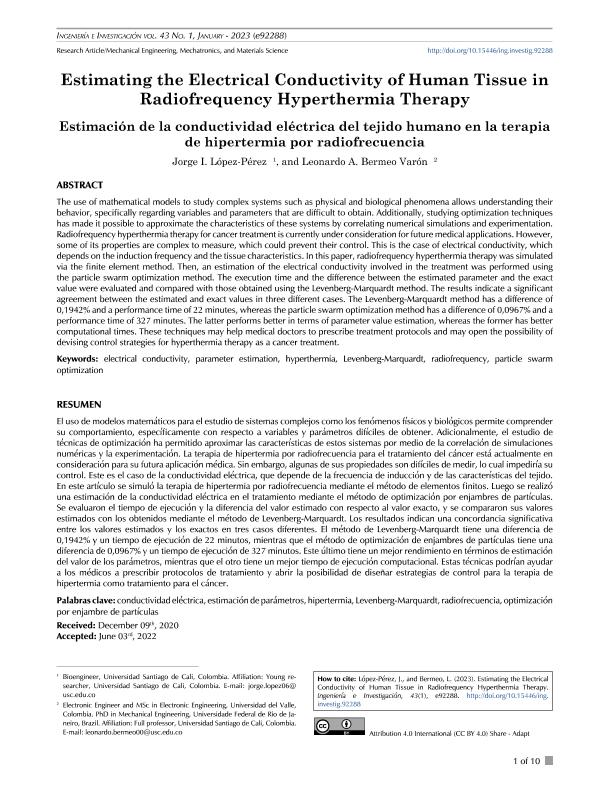Mostrar el registro sencillo del ítem
dc.contributor.author
Lopez Perez, Jorge Iván

dc.contributor.author
Bermeo Varón, L. A.
dc.date.available
2023-10-04T16:42:33Z
dc.date.issued
2023-01
dc.identifier.citation
Lopez Perez, Jorge Iván; Bermeo Varón, L. A.; Estimating the Electrical Conductivity of Human Tissue in Radiofrequency Hyperthermia Therapy; Universidad Nacional de Colombia; Ingeniería e Investigación; 43; 1; 1-2023; 1-10
dc.identifier.issn
0120-5609
dc.identifier.uri
http://hdl.handle.net/11336/214124
dc.description.abstract
The use of mathematical models to study complex systems such as physical and biological phenomena allows understanding their behavior, specifically regarding variables and parameters that are difficult to obtain. Additionally, studying optimization techniques has made it possible to approximate the characteristics of these systems by correlating numerical simulations and experimentation. Radiofrequency hyperthermia therapy for cancer treatment is currently under consideration for future medical applications. However, some of its properties are complex to measure, which could prevent their control. This is the case of electrical conductivity, which depends on the induction frequency and the tissue characteristics. In this paper, radiofrequency hyperthermia therapy was simulated via the finite element method. Then, an estimation of the electrical conductivity involved in the treatment was performed using the particle swarm optimization method. The execution time and the difference between the estimated parameter and the exact value were evaluated and compared with those obtained using the Levenberg-Marquardt method. The results indicate a significant agreement between the estimated and exact values in three different cases. The Levenberg-Marquardt method has a difference of 0,1942% and a performance time of 22 minutes, whereas the particle swarm optimization method has a difference of 0,0967% and a performance time of 327 minutes. The latter performs better in terms of parameter value estimation, whereas the former has better computational times. These techniques may help medical doctors to prescribe treatment protocols and may open the possibility of devising control strategies for hyperthermia therapy as a cancer treatment.
dc.description.abstract
El uso de modelos matemáticos para el estudio de sistemas complejos como los fenómenos físicos y biológicos permite comprender su comportamiento, específicamente con respecto a variables y parámetros difíciles de obtener. Adicionalmente, el estudio de técnicas de optimización ha permitido aproximar las características de estos sistemas por medio de la correlación de simulaciones numéricas y la experimentación. La terapia de hipertermia por radiofrecuencia para el tratamiento del cáncer está actualmente en consideración para su futura aplicación médica. Sin embargo, algunas de sus propiedades son difíciles de medir, lo cual impediría su control. Este es el caso de la conductividad eléctrica, que depende de la frecuencia de inducción y de las características del tejido. En este artículo se simuló la terapia de hipertermia por radiofrecuencia mediante el método de elementos finitos. Luego se realizó una estimación de la conductividad eléctrica en el tratamiento mediante el método de optimización por enjambres de partículas. Se evaluaron el tiempo de ejecución y la diferencia del valor estimado con respecto al valor exacto, y se compararon sus valores estimados con los obtenidos mediante el método de Levenberg-Marquardt. Los resultados indican una concordancia significativa entre los valores estimados y los exactos en tres casos diferentes. El método de Levenberg-Marquardt tiene una diferencia de 0,1942% y un tiempo de ejecución de 22 minutos, mientras que el método de optimización de enjambres de partículas tiene una diferencia de 0,0967% y un tiempo de ejecución de 327 minutos. Este último tiene un mejor rendimiento en términos de estimación del valor de los parámetros, mientras que el otro tiene un mejor tiempo de ejecución computacional. Estas técnicas podrían ayudar a los médicos a prescribir protocolos de tratamiento y abrir la posibilidad de diseñar estrategias de control para la terapia de hipertermia como tratamiento para el cáncer.
dc.format
application/pdf
dc.language.iso
eng
dc.publisher
Universidad Nacional de Colombia

dc.rights
info:eu-repo/semantics/openAccess
dc.rights.uri
https://creativecommons.org/licenses/by/2.5/ar/
dc.subject
ELECTRICAL CONDUCTIVITY
dc.subject
HYPERTHERMIA
dc.subject
LEVENBERG-MARQUARDT
dc.subject
PARAMETER ESTIMATION
dc.subject
PARTICLE SWARM OPTIMIZATION
dc.subject
RADIOFREQUENCY
dc.subject.classification
Otras Ingeniería Médica

dc.subject.classification
Ingeniería Médica

dc.subject.classification
INGENIERÍAS Y TECNOLOGÍAS

dc.title
Estimating the Electrical Conductivity of Human Tissue in Radiofrequency Hyperthermia Therapy
dc.title
Estimación de la conductividad eléctrica del tejido humano en la terapia de hipertermia por radiofrecuencia
dc.type
info:eu-repo/semantics/article
dc.type
info:ar-repo/semantics/artículo
dc.type
info:eu-repo/semantics/publishedVersion
dc.date.updated
2023-10-03T10:24:07Z
dc.identifier.eissn
2248-8723
dc.journal.volume
43
dc.journal.number
1
dc.journal.pagination
1-10
dc.journal.pais
Colombia

dc.journal.ciudad
Medellín
dc.description.fil
Fil: Lopez Perez, Jorge Iván. Consejo Nacional de Investigaciones Científicas y Técnicas. Centro Científico Tecnológico Conicet - Bahía Blanca. Instituto de Ciencias e Ingeniería de la Computación. Universidad Nacional del Sur. Departamento de Ciencias e Ingeniería de la Computación. Instituto de Ciencias e Ingeniería de la Computación; Argentina. Universidad Santiago de Cali; Colombia
dc.description.fil
Fil: Bermeo Varón, L. A.. Universidad Santiago de Cali; Colombia
dc.journal.title
Ingeniería e Investigación

dc.relation.alternativeid
info:eu-repo/semantics/altIdentifier/url/https://revistas.unal.edu.co/index.php/ingeinv/article/view/92288
dc.relation.alternativeid
info:eu-repo/semantics/altIdentifier/doi/https://doi.org/10.15446/ing.investig.92288
Archivos asociados
